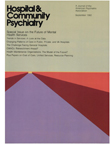How Many Beds? An Overview of Resource Planning
Abstract
Determining the number of beds a community needs for the treatment of psychiatric patients has long been a concern of health planners. Variations in the definition of what constitutes a "bed" and in the mental health systems, environmental and social factors, financial considerations, and planning techniques found in each community all have contributed to making resource planning a difficult and highly localized task. The authors discuss these and other issues that planners must take into account in arriving at an estimated number of beds for psychiatric treatment, and point to the planning efforts of California, Nebraska, and Great Britain as three comprehensive approaches. They caution that there are no definitive answers to the questions posed by resource planning and encourage efforts to better classify resources, to provide more information on service systems, and to first design comprehensive community services before eliminating acute inpatient care beds.
Access content
To read the fulltext, please use one of the options below to sign in or purchase access.- Personal login
- Institutional Login
- Sign in via OpenAthens
- Register for access
-
Please login/register if you wish to pair your device and check access availability.
Not a subscriber?
PsychiatryOnline subscription options offer access to the DSM-5 library, books, journals, CME, and patient resources. This all-in-one virtual library provides psychiatrists and mental health professionals with key resources for diagnosis, treatment, research, and professional development.
Need more help? PsychiatryOnline Customer Service may be reached by emailing [email protected] or by calling 800-368-5777 (in the U.S.) or 703-907-7322 (outside the U.S.).



